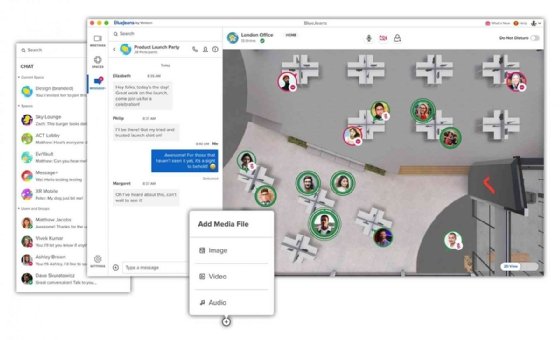
andreaobzerova - stock.adobe.com
Pandemic renews enterprise virtual reality for collaboration
Enterprise virtual reality may make a comeback as businesses look to improve support for remote and hybrid collaboration. But the question is whether VR is the right technology.
Video conferencing solved some of the communication issues that emerged with the influx of remote work during the COVID-19 pandemic. Many organizations relied on video calls to replace in-person meetings and collaboration sessions that couldn't happen in offices.
But video has struggled to create a fully immersive experience for meeting participants and replicate the casual collaboration in an office setting. Organizations and communication providers alike are trying to solve these problems. And, for some, the answer lies in virtual reality (VR).
The question, however, is whether VR is the right technology to address these new collaboration needs. Communication vendors, like Avaya, introduced and shuttered VR platforms due to a lack of enterprise adoption and interest.
Yet COVID-19 created new communication and collaboration needs, which could spark interest in enterprise virtual reality and lead to mass adoption, said Tom Brannen, analyst and founder of OnConvergence LLC.
Brannen and other industry insiders spoke at Enterprise Connect about the renewed interest in VR for remote communications and collaboration and the challenges facing adoption.
COVID-19 drives enterprise virtual reality
VR creates a more immersive experience than a video call, Brannen said. Avatars, virtual environments and spatial audio help create these enveloping worlds.
With spatial audio, users can hear sound all around them rather than from audio equipment in a fixed location. Spatial audio also enables meeting participants to have more control over who they interact with during the meeting, he said. While in a large meeting, small groups of people can have private conversations that can't be heard by others unless they're near the group.
Meeting platforms like Zoom and Microsoft Teams try to recreate these side conversations with breakout rooms, but they lack the immersive feeling that VR offers, he said.
In addition to meetings, VR can support training and onboarding in a hybrid workforce to ensure employees feel engaged and part of a team even when people are remote. For example, when new employees joined a team before the pandemic, the team could go out to lunch or do other activities to get to know each other. Many of these activities aren't possible during the pandemic. But teams could use VR for virtual activities to make new employees feel welcome and included, he said.
"We're seeing culture get diffused as the remote workforce wears on," Brannen said. "VR provides some great avenues to drive culture."
Vendors seize VR opportunity, face obstacles
Several communications vendors have recently introduced enterprise virtual reality initiatives to address the need for more immersive virtual meetings and collaboration. Facebook, for example, launched in August an open beta of Horizon Workrooms, where employees can use Oculus Quest 2 headsets to meet and access capabilities like remote desktop streaming and video conferencing from a virtual workspace.
Zoom announced an upcoming integration with Horizon Workrooms to enable employees to join Zoom meetings and access Zoom's whiteboard app from within the VR workspace.
BlueJeans by Verizon recently announced BlueJeans Spaces, a virtual workspace that simulates the office experience. When the product launches next year, employees can use the workspace for meetings and more casual and ad hoc communications. However, at launch, Spaces will only support desktop environments.

VR still faces roadblocks in mainstream enterprise acceptance for immersive, virtual meetings. Specifically, IT management will be a challenge in terms of security and managing VR meetings at scale, Brannen said.
User acceptance is a major hurdle as users need to overcome preconceived notions of what a VR experience entails. Most people also don't like the form factor of VR headsets, which is a significant challenge to overcome, he said.
A solution looking for a problem
While some communications vendors are exploring VR as the next big thing in virtual meetings, the question is whether the technology will catch on for meetings outside of niche use cases.
"It seems like one of those technologies that comes along every few years in the collaboration space, and then disappears for lack of usability or use cases," said Metrigy analyst Irwin Lazar. With the consumer acceptance of VR and VR devices making their way into enterprises, it's possible the technology could see wider adoption for business purposes. But it's not for everyone.
"I'm not a believer," said David Kung, director of product marketing at Bluescape. VR meetings could work in situations where a sole participant is so remote that a more immersive experience is needed. But Kung said he doesn't think people want to have their general meetings mediated by a device like a VR headset.
Mixed reality applications -- a combination of virtual and augmented reality -- could see more use in the enterprise as a way to visualize content and move beyond screen sharing during a meeting, Kung said.
"When we get more oriented on understanding the use cases, the applications pop out," said Hunter Middleton, senior vice president of product management at 8x8. For example, no one cared about having virtual backgrounds for video meetings until everyone's backgrounds were kids' toys and messy rooms at home, he said.
Right now, the problems facing remote and hybrid work collaboration don't necessarily need VR to solve them, he said.
Part of the problem with VR is the technology is trying to recreate the physical world, said Steve Wood, vice president of product and developer platform at Slack. The UC industry is trying to solve the challenge of supporting the casual communication that occurs when employees work near each other. To be more effective, he said, vendors should offer technology that improves the digital workplace experience, and not just recreate the physical office.
"There's a craving to get that back again," he said. "Let's try to find some interesting ways rather than strapping on some massive goggles and trying to pretend the virtual world is the real world."








